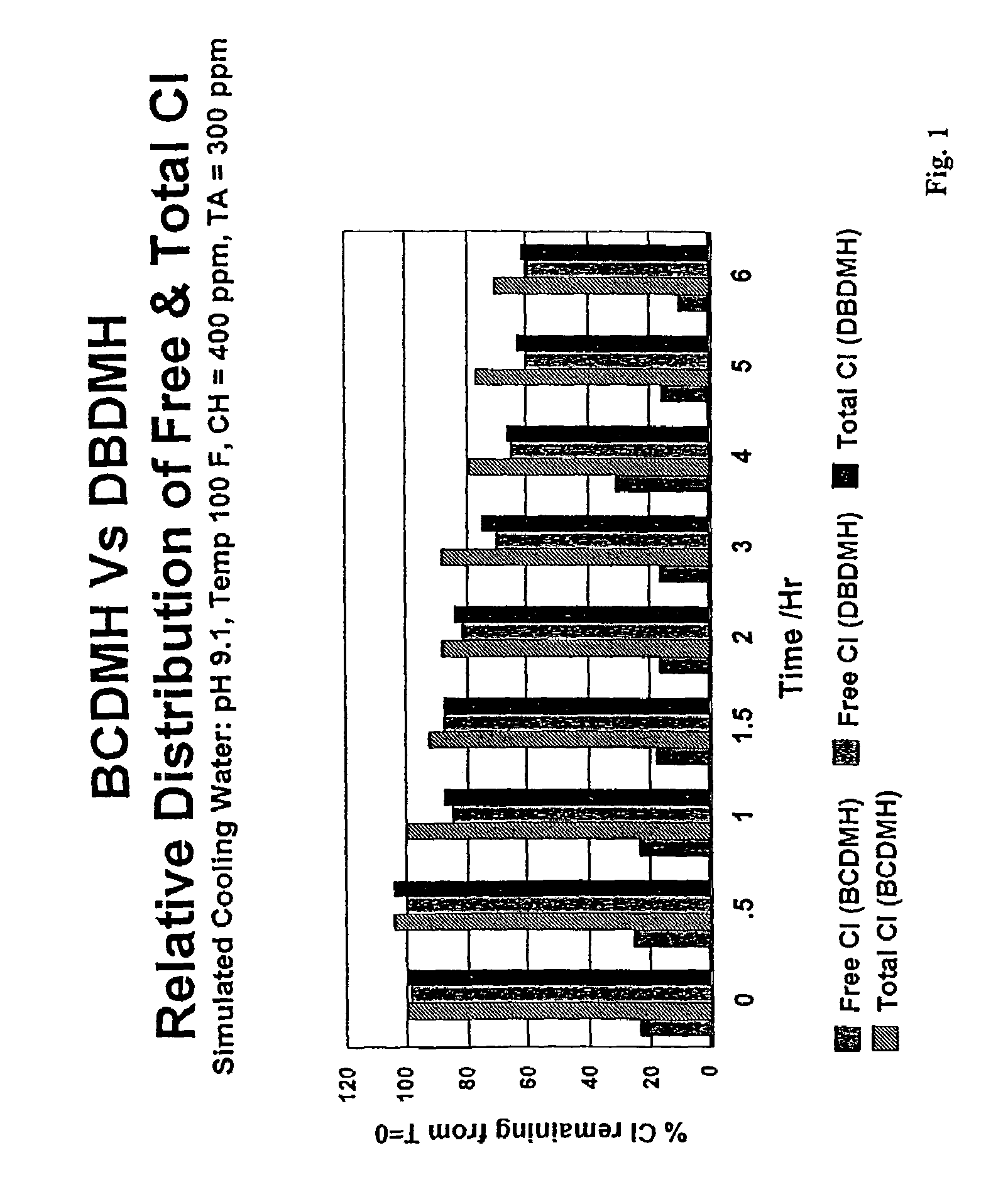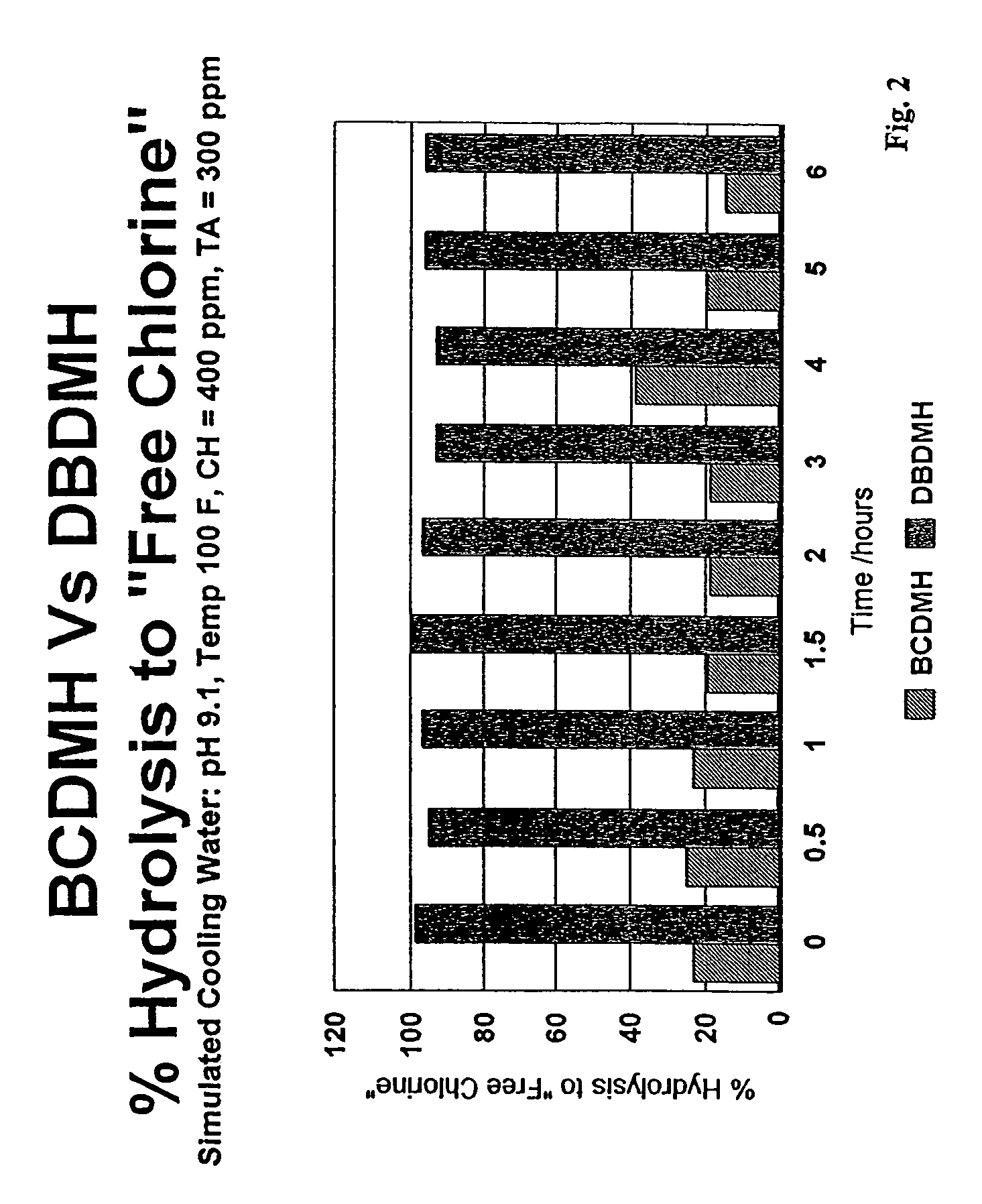Methods for microbiological control in aqueous systems
a microbiological control and aqueous technology, applied in the field of methods for microbiological control in aqueous systems, can solve the problems of consumer's unknowingly contributing to the release of undesirable quantities of halogenated materials, pay for relatively ineffective microbiocidal agents, etc., to achieve microbiocidal control, maintain microbiocidal control, and reduce the amount of halogenated materials
- Summary
- Abstract
- Description
- Claims
- Application Information
AI Technical Summary
Benefits of technology
Problems solved by technology
Method used
Image
Examples
example 1
[0041]Simulated cooling water was prepared using deionized water to which calcium chloride and sodium bicarbonate were added to provide calcium hardness of 400 ppm and a total alkalinity of 300 ppm. A small amount of phosphonobutanetricarboxylic acid (PBTC) (5 ppm) was used to prevent calcium carbonate precipitation. Concentrated sodium hydroxide was added to adjust the pH of the simulated cooling water solutions to pH 9.1.
[0042]Stock solutions of DBDMH and of BCDMH were prepared by slurrying 1 gram of the respective powders in 100 mL of deionized water. After stirring for 20 minutes, the insolubles were filtered to yield clear saturated stock solutions of DBDMH and BCDMH, respectively. Iodometric titration of the stock solutions using the potassium iodide-sodium thiosulfate method indicated the DBDMH solution contained 580 mg / L (as total chlorine), and the BCDMH solution contained 1100 mg / L (as total chlorine).
[0043]The stock solutions were used to dose two simulated cooling water ...
example 2
[0047]The effectiveness of DBDMH and of BCDMH in microbiological control in cooling tower water was investigated in comparative tests. The cooling tower consisted of two 500-ton units in a crossflow design. The total system-contained volume was 14,000 gallons, and the tower contained medium efficiency film fill. Water from the tower cooled the coils of two 300-ton air conditioners (chillers). The tower typically operated at a pH of about 9.1 and 4 cycles of concentration. Blowdown was controlled by conductivity. Make-up water consisted of softened city water and which was of good quality. The make-up water was very low in calcium (3), and the silica level was 28 mg / L. The tower employed a conventional polyphosphate / molybdate-phosphonate program to provide corrosion and deposit control. The conditions and results are summarized in Table 3.
[0048]
TABLE 3*Cooling Tower WaterMake-up WaterCooling Tower DataTemperature (return line)91° F.—Temperature (to process)83° F.—ΔT 8° F.—Make-up wat...
example 3
[0052]Using the same cooling tower as used in Example 2, the effectiveness of 1,3-dibromo-5,5-dimethylhydantoin in microbiological control in cooling tower water was investigated. As noted above, the cooling tower consisted of two 500-ton units in a crossflow design. The total system-contained volume was 14,000 gallons, and the tower contained medium efficiency film fill. Water from the tower cooled the coils of two 300-ton air conditioners (chillers). The tower typically operated at a pH of about 9.1 and 4 cycles of concentration. Blowdown was controlled by conductivity. Make-up water consisted of softened city water and which was of good quality. The make-up water was very low in calcium (3), and the silica level was 28 mg / L. The tower employed a conventional polyphosphate / molybdate / phosphonate program to provide corrosion and deposit control.
[0053]The 1,3-dibromo-5,5-dimethylhydantoin was introduced to the water using granules charged to a solid halogen feeder (Neptune model BT-4...
PUM
| Property | Measurement | Unit |
|---|---|---|
| Mass | aaaaa | aaaaa |
| Mass | aaaaa | aaaaa |
| Fraction | aaaaa | aaaaa |
Abstract
Description
Claims
Application Information
 Login to View More
Login to View More - R&D
- Intellectual Property
- Life Sciences
- Materials
- Tech Scout
- Unparalleled Data Quality
- Higher Quality Content
- 60% Fewer Hallucinations
Browse by: Latest US Patents, China's latest patents, Technical Efficacy Thesaurus, Application Domain, Technology Topic, Popular Technical Reports.
© 2025 PatSnap. All rights reserved.Legal|Privacy policy|Modern Slavery Act Transparency Statement|Sitemap|About US| Contact US: help@patsnap.com



